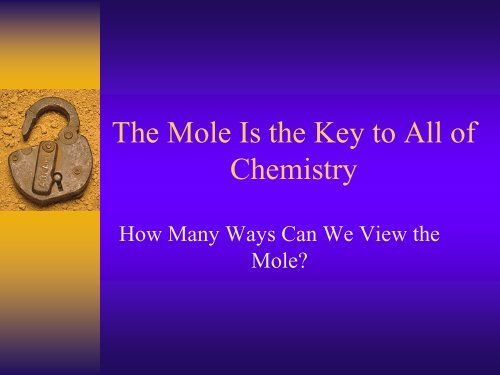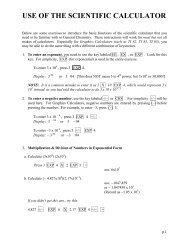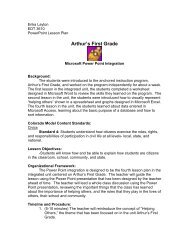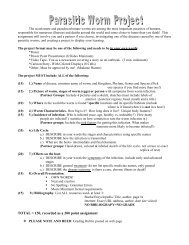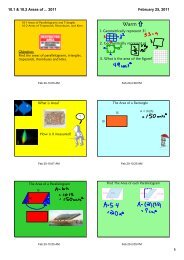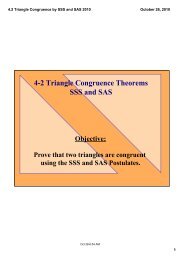The Mole PowerPoint
The Mole PowerPoint
The Mole PowerPoint
- No tags were found...
Create successful ePaper yourself
Turn your PDF publications into a flip-book with our unique Google optimized e-Paper software.
<strong>The</strong> <strong>Mole</strong> Is the Key to All ofChemistryHow Many Ways Can We View the<strong>Mole</strong>?
How Big is Avogadro’s Number?♦ Just for fun, let’s imagine that a mole ofdollars was created with the world, 4.5billion years ago.♦ If this money was given away at the rate of$1,000,000/second, when did it run out?♦ Or, if it hasn’t run out, how much is left?♦ <strong>The</strong>re is still $4.6 x 10 23 left! Only about1/4 of it has been given away so far!
How Big is Avogadro’s Number?♦ Yes, the mole is a huge number of items.♦ But, since atoms and molecules are verysmall, that’s OK.♦ We use similar names for smaller numbersof larger items.♦ For example, a dozen. Does it matter whatobjects we are counting?♦ If we have a dozen, we know there are 12objects, whatever they are.
Carbon-12♦ C-12 is the relative standard for atomicmass. That is, the masses of all other atomsare compared to C-12.♦ So, C-12 atoms are defined as having amass of exactly 12.0000 amu.♦ So, where does Avogadro’s number fit intoall of this?6.02 x 10 23atomsC-12 <strong>Mole</strong>
<strong>The</strong> Magic of Avogadro’sNumber♦ Was Avogadro’s number chosen at random?♦ Was it chosen to confuse science students?♦ Probably not.♦ Avogadro’s number was picked so that ifone knows the relative atomic mass of anelement, one also knows the mass of 1 moleof that element.
<strong>The</strong> Magic of Avogadro’s♦ It’s easy!Number♦ Let’s take Mg as an example.♦ <strong>The</strong> periodic table says the relative atomicmass of Mg is 24.3 amu.♦ <strong>The</strong>refore, 1 mole, or 6.02 x 10 23 atoms ofMg have a mass of 24.3 grams!♦ To know the mass of a mole, simply changeatomic mass units to grams. This is how wecount atoms!
<strong>The</strong> Magic of Avogadro’sNumber♦ What is the atomic mass of sulfur?♦ 32.06 or 32.1 amu.♦ What is the mass of 1 mole of sulfur?♦ 32.1 grams.♦ How many atoms is that?♦ 6.02 x 10 23 is correct!!♦ What is the molar mass of Ag?♦ 107.9 grams.
Why Bother?♦ We often choose to count large numbers ofsmall objects by mass or weight, mostlybecause counting them individually is apain or even impossible.♦ Atoms are too small to even seeindividually, let alone count. So we mustcount them in a different way.
An Example♦ You have been hired to build a fence arounda square lot that is 100 ft. on a side.♦ Fence boards are 6 inches wide, and youintend to put 6 nails in each board.♦ How many nails do you need?♦ Are you actually going to the hardwarestore and individually count out 4800 nails?♦ Probably not. <strong>The</strong>y are sold by the pound.
An Example♦ If there are 400 nails in a pound, you wouldneed 12 pounds of nails.♦ If you weigh out 12 pounds, what are thechances you will have exactly 4800 nails?♦ Not very likely. Does it matter if you areoff by a few?♦ If we mass out a mole of atoms and are offby a few million, it really doesn’t matter!
Complete This TableElementAtomicMass(to 1 dec.)GramAtomicMassNumber of<strong>Mole</strong>sNumber ofAtomsHCSnAu
Complete This TableElementAtomicMass(to 1 dec.)GramAtomicMassNumberof <strong>Mole</strong>sNumber ofAtomsH 1.0 amu 1.0 g 1 6.02 x10 23C 12.0 amu 12.0 g 1 6.02 x10 23Sn 118.7 amu 118.7 g 1 6.02 x10 23Au 197.0 amu 197.0 g 1 6.02 x10 23
Rounding♦ Be careful when rounding masses from theperiodic table.♦ Look at all the digits, then round to thenearest 1 decimal place.♦ Ex. Oxygen♦ 15.9994 ≠ 15.9!♦ 15.9994 = 16.0
Mini Quiz1. What is the mass of 1 (average) arsenicatom?2. What is the mass of 6.02 x 10 23 As atoms?3. What is the mass of 1 mole of As atoms?4. What is the gram atomic mass of As?Answers1. 74.9 amu2, 3, 4. 74.9 g
Counting Other Particles♦ What if we need to count other particlesthan atoms?♦ We can also use the same idea to count– <strong>Mole</strong>cules (particles of covalent compounds)– Formula Units (particles of ionic compounds)♦ All we need to do is add up the masses ofall the atoms or ions in the formula.♦ We calculate a formula mass for the cpd.
Molar Mass♦ <strong>The</strong> mass in grams of 1 mole of anysubstance is its molar mass.♦ Lets use water for an example.♦ Water is covalent. A water molecule isH 2 O. Two H atoms and one O atom.♦ 2 H atoms (1.0 amu/atom) = 2.0 amu♦ 1 O atom (16.0 amu/atom) = 16.0amu♦ 2.0 amu + 16.0 amu = 18.0 amu/1 molecule
Molar Mass1.0 1.016.0A single water molecule is 1.0 + 1.0 + 16.0or 18.0 amu.<strong>The</strong>refore, 1 mole of water = 18.0 grams, themolar mass of water.
Converting to and from moles.♦ To convert between moles and particles,simply multiply or divide by Avogadro’snumber.♦ 2 mol 6.02 x 10 23 particles1 mol = 1.20 x 10 24 particles♦ 3.1 x 10 24 particles 1 mol6.02 x 10 23 particles = 5 mol
Converting to and from moles.♦ Converting between moles and massrequires the molar mass of the substancefrom the periodic table.♦ Element: Ag = 107.9g/mol♦ Ionic compound: CaCl 2 = 111.1 g/mol♦ Covalent compound: NO 2 = 46.0 g/mol♦ Always keep at least one decimal place onall values taken from the periodic table.
Converting to and from moles.♦ To convert from moles to grams, multiplyby molar mass:♦ 0.50 mol H 2 O x (18.0g/mol) = 9.00g H 2 O♦ To convert from grams to moles, divide bymolar mass:♦ 54g H 2 O x (1mol/18.0g) = 3.0 mol H 2 O
Converting to and from moles.♦ For gases, use the fact that at STP, 1 mol ofany gas has a volume of 22.4 Liters.♦ What is STP? Standard Temperature andPressure♦ Standard Temperature = 273K or 0°C♦ Standard Pressure = 1 atmosphere = 760mm Hg (barometric) = 100 kPa.
Converting to and from moles.♦ To go from moles to volume, multiply by22.4L.♦ 3.00 mol x (22.4L/mol) = 67.2L of gas♦ To go from volume to moles, divide by22.4L♦ 44.8L x (1mol/22.4L) = 2.00 moles of gas
Converting to and from moles.♦ A convenient tool for making theseconversions is called a “mole map.”♦ With the mole at the center, we can put allof the aforementioned calculations togetherinto one simple picture.
<strong>The</strong> <strong>Mole</strong> MapGasVolume@ STPx22.4L÷<strong>Mole</strong>x6.02 x 10 23#Particles÷÷MolarMassxMass


